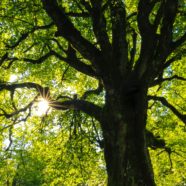Arboreal Revelation
I’ve been working on a new chapter about trees as part of my current book project, Hopeful Inhumanism: The Elemental Aesthetics of Ecocatastrophe. Titled “Arboreal Revelation,” the chapter will extend my analysis in earlier case studies on rocks (“Becoming-lithic”) and fungus (“Mycological Possibility”), which considers the elemental aesthetics of texts that dismantle humanist and anthropocentric perspectives to reveal what the Victorian naturalist Richard Jeffries (author of the early ecocatastrophe, After London; or, Wild England [1885]) called “the ultra-humanity of all that is not man.”
I’ll be presenting some of this new research material in my keynote for the “Between fiction and society: Imagination and worldbuilding in the aftermath of a global pandemic” conference being held at IULM, Milan in October 2022. Below is my abstract for the keynote.
Arboreal revelation at the world’s beginning
IULM University, Milan, October 2022
Keynote Abstract
What can we learn from the weird woods? How might forests, trees, and the fungal and microbial worlds within which they are entangled, offer clues for surviving the ongoing ecocatastrophe?
This keynote will consider the elemental aesthetics of literary and cultural texts that privilege the nonhuman perspectives of trees, and other arborescent and mycological partners. Drawing on anthropological studies into “how forests think” (Eduardo Kohn), I will consider what kind of “arboreal revelation” is suggested by the inescapably cultural processes that bind humans, trees, plants, and fungal and microbial partners together. I will discuss the fig tree narrator in Elif Shafak’s The Island of Missing Trees (2021), arboreal point in view in Richard Powers’ Overstory (2018), the drag and visual artist Sasha Velour’s performance as a dogwood tree in her 2019 show “Smoke and Mirrors,” the sonic arrangement of trees, mycorrhizal electrical signals, and birdsong in Joe Acheson’s “Sonic Woodland” series (2018-2021), and Nalo Hopkinson’s animal-arboreal solidarity in the fantastical remediation of the baobab tree in Midnight Robber (2000). I argue that these literary, performative, and sonic texts offer explicitly utopian meditations upon arboreal interconnectedness that overturns an older sylvaphobia in Gothic and supernatural tales about haunted weird woods (John Miller).
If we are to adapt and survive what Rob Nixon called the “slow violence” of ecocatastrophe, we need to attune our elemental understanding of woods, trees, and the fungal and microbial worlds within which they are entangled. These weird modalities of nonhuman temporality and representation help us rethink how the human might be continuous with the arboreal – not just at metaphorical, but insistently cellular and material, levels. Finally, I think they offer clues as to how the woody, parenchymatous longue durée of arboreal deep time gestures towards a sylvan realm of nonhuman futurity – that includes humans, reconstituted as inhuman agents within a post-anthropocentric ecosystem.
Below is a video recording of the keynote and Q&A. You can also watch this and other similar keynotes and talks on my YouTube channel.







 Dr Caroline Edwards is Senior Lecturer in Modern & Contemporary Literature at Birkbeck, University of London. Her research and teaching specialisms are in 21st century literature and critical theory, science fiction and post-apocalyptic narratives, Marxist aesthetics, and utopianism.
Dr Caroline Edwards is Senior Lecturer in Modern & Contemporary Literature at Birkbeck, University of London. Her research and teaching specialisms are in 21st century literature and critical theory, science fiction and post-apocalyptic narratives, Marxist aesthetics, and utopianism.
Follow / Contact